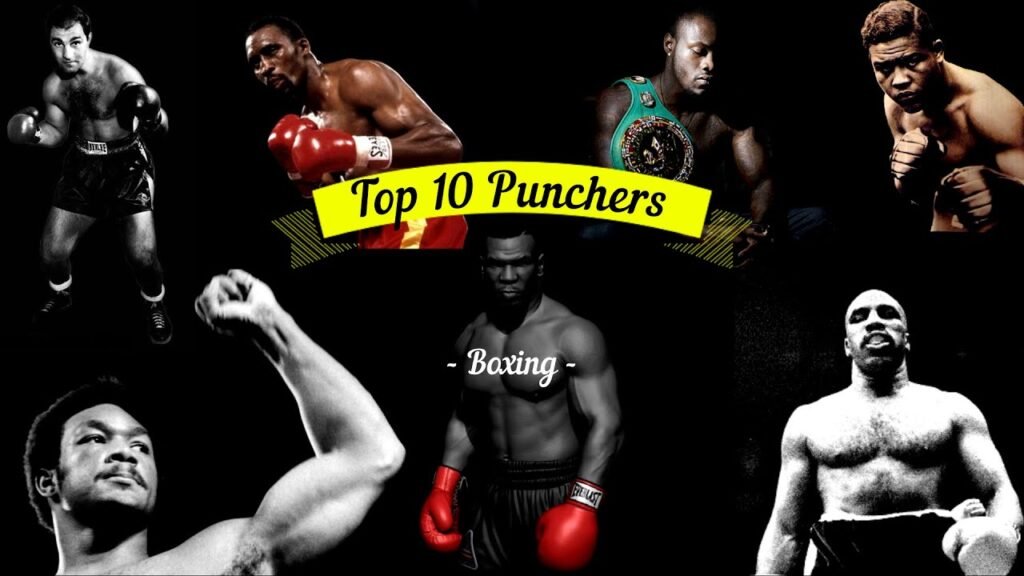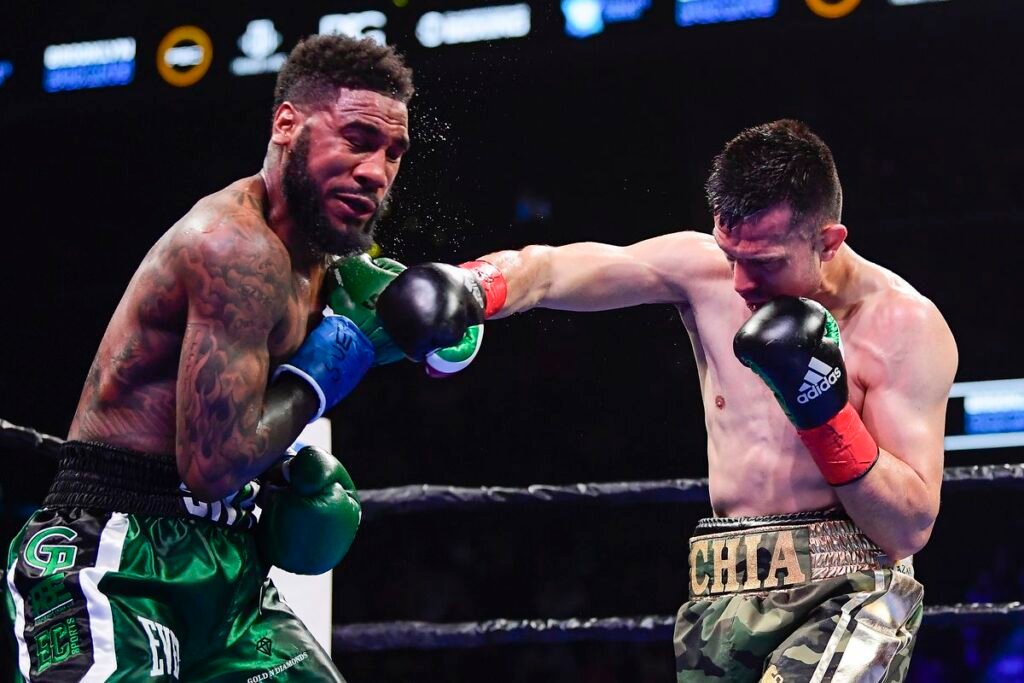The ability to knock an opponent out with a single punch separates the pretenders from the contenders in the sport of boxing. As the great Mike Tyson once said, “Everybody has a plan until they get punched in the mouth.” Throughout history, only a rare breed of fighters possess truly devastating one-punch power.
This article definitively ranks and analyzes the 10 boxers with the most powerful punches of all time. Factors like knockout percentage, total knockouts, longevity, and dominance are weighed along with extensive visual analysis of knockout reels. Advanced metrics including PunchScore are also incorporated to assess explosive impact.

Let’s break down the criteria used to determine the top 10 and reveal who ranks as the #1 most powerful puncher ever.
Contents
- 0.1 What makes some boxers punch harder than others?
- 0.2 Measuring punching power in boxers
- 0.3 Setting the criteria for the list
- 0.4 #10 Most Powerful Puncher: Julian Jackson
- 0.5 #9 Most Powerful Puncher: Wilfredo Gómez
- 0.6 #8 Most Powerful Puncher: Gerald McClellan
- 0.7 #7 Most Powerful Puncher: Ruben Olivares
- 0.8 #6 Most Powerful Puncher: Joe Louis
- 0.9 #5 Most Powerful Puncher: Archie Moore
- 0.10 #4 Most Powerful Puncher: Samuel Peter
- 0.11 #3 Most Powerful Puncher: George Foreman
- 0.12 #2 Most Powerful Puncher: Mike Tyson
- 0.13 #1 Most Powerful Puncher: Earnie Shavers
- 1 Conclusion
What makes some boxers punch harder than others?
Massive punching power stems from a combination of exceptional physical attributes and flawless technique:
- Muscle mass – Boxers with more muscular arms, shoulders and core generate greater force. But too much bulk can slow fighters down. Finding the optimal ratio is key.
- Leverage – Tall fighters with long arms gain leverage advantages that amplify power like a whip. Short explosive punchers combine speed with perfect accuracy to land bombs.
- Technique & accuracy – Flawless technique and precision accuracy are imperative for transferring maximum force on impact. Missing the sweet spot drastically reduces damage.
- Timing & setups – Masterful ring generalship and perfect timing ensure knockout blows land flush before opponents react. Setups and feints maneuver opponents into compromised positions.
While raw power is critical, factors like timing, placement, balance, and distance management also influence perceptions of dominance.
For example, a sharp counter puncher with a 70% KO ratio can look more explosive than an 80% power puncher lacking finesse and fluidity.
New performance indicators aim to quantify impact force. PunchScore uses fight data and physics to calculate scoring efficiency and damage ratings for every strike. Another metric called Knockout Energy Efficiency expresses fighters’ knockout rates per pound of impact.
Let’s examine the main statistical measures for assessing all-time great punching power.
Measuring punching power in boxers
Knockout percentage is the most widely cited metric. By dividing knockouts by total wins, KO ratio filters for consistency separating knockout artists from those padding records against tomato cans.
But KO percentage has limitations:
- Schedule quality affects ratios, giving advantage to protected fighters
- KOs dependent on many variables beyond raw force
- One-punch power differs from gradual TKO accumulations
Other useful statistical measures of punching power include:
- Knockouts per round – Displays efficiency ending fights quickly
- Consecutive knockouts – Multi-fight KO streaks demonstrate prolonged power
- Total KOs – High numbers demand longevity sustaining dominance
- Opposition KO% – Context of rivals’ durability
- Withstood KOs – Surviving early bombs displays toughness
While vital, metrics capture one aspect of the complex dynamics generating knockouts. No substitute exists for visually analyzing finishing sequences.
Let’s set the criteria for this definitive list combining statistics, longevity, opposition quality, and visual assessments of emphatic KOs.

Setting the criteria for the list
Given the complexity of ranking punching power, a multi-pronged approach is deployed here across statistical, competition, and visual analysis factors:
- Knockout percentage – Minimum requirement: 65% KO ratio
- Opposition quality – Elite competition facing top fighters
- One-punch KOs – Raw explosive highlight reel KOs
- Longevity – Sustained excellence KOing top fighters over long careers
- **Visually devastation KOs ** – Utter domination leaving zero doubt
- Intimidation factor – Reputation striking fear across divisions
This criteria ensures all ten fighters crack opponents with a venom combining technique, accuracy, timing, power, longevity, consistency, and style perfectly to generate all-time great KOs worthy of endless highlight reels.
Let the bodies hit the floor as we start the countdown with #10…
#10 Most Powerful Puncher: Julian Jackson
“The Hawk” fittingly swooped down from the sky dropping opponents in spectacular fashion. Jackson combined possibly the highest peak one-punch power ever with a trademark spectacular knockout reel to earn his fearsome reputation.
Jackson’s numbers stack up against the division’s greatest punchers:
- 55 KOs in 59 wins – 93% KO ratio
- 49 stoppages inside 5 rounds – 83% ratio
Jackson’s explosive style overwhelmed Norris while boxers feared his famously concussive power. But a flawed chin hampered Jackson from sustaining dominance. Lacking longevity keeps Jackson at #10 given his transcendent power appearing capable of sleeping anyone.
#9 Most Powerful Puncher: Wilfredo Gómez
Wilfredo Gómez earned his nickname “Bazooka” blasting opponents with vicious power that translated upwards in weight for twenty years.
- 44 straight KO streak from ’76-’82 – record
- Career: 44 KOs in 48 Wins – 92% ratio
Gómez defeated 17 world champions while showcasing persistent one-punch explosives flooring durable Featherweights and Junior Lightweights alike fight after fight. Rare longevity at the elite level keeps his KO record untarnished among history’s most powerful punchers.
#8 Most Powerful Puncher: Gerald McClellan
Gerald McClellan defined explosiveness during his blistering rise towards middleweight supremacy. McClellan’s thudding power resulted in emphatic KOs that earned comparisons to a prime Mike Tyson.
- KO ratio: 88% with 30 KOs in 34 wins
- 20 straight KO streak
McClellan punctuated his highlight reel applying smart pressure fighting. Switching fluidly between orthodox and southpaw stances, he maneuvered opponents into compromised positions then closed with alarming speed. McClellan’s ability sustaining his dominance revealed a potential all-time great tragically cut short.
#7 Most Powerful Puncher: Ruben Olivares
A technician who honed his destructive left hook into possibly the most potent in boxing history. Olivares demonstrated elusive mastery setting up the perfect punch leading to an 88% KO ratio and 63 KOs in just 72 wins.
- 63 KOs – 88% KO Ratio at Bantamweight
- KO streaks of 21 and 22 fights
Known as “El Puas,” his darting lead hook often badly hurt world class fighters. Olivares possessed advanced skill feinting opponents into walking blindly into counters timed with shocking power. Hitting far above his 118 lb featherweight class, Olivares earned his reputation as a monstrous one-punch puncher no one wanted to face.
#6 Most Powerful Puncher: Joe Louis
“He can whoop anybody in the world. It’ll take Jack Johnson to beat him.” declared Jack Blackburn, Louis’ trainer. Nicknamed the Brown Bomber for his devastating power, Louis often severely punished iron-chinned opponents in frightening KOs warranting comparisons to Deontay Wilder’s modern eras might.
- Held world heavyweight title 1935 to 1949 – record 11 year 9 month reign
- KO percentage: 76% – 52 KOs in 69 Wins
- Fought 25 Hall of Fame boxers – facing all-time competition
Analyzing the quality of competition reveals the mythic status behind Louis’ power against top fighters. Unlike Marciano fighting mostly C-tier boxers, Louis consistently demolished elite Hall of Famers through a grueling 25 title defenses.
#5 Most Powerful Puncher: Archie Moore
The Mongoose aged like fine wine – his power peaking later getting deadlier over an astounding 28 year career. Moore scored emphatic single-shot KOs that earned his reputation finishing 141 of 181 wins by knockout.
- Career: 68% KO ratio – 131 KOs in 193 Wins
- Light heavyweight KOs: 100 KOs in 135 Wins – 74% KO Ratio
- Age 36+: 62 Wins – 86% KO ratio
Moore displayed persistent power maintaining 70%+ KO ratios well into his 40s even fighting legends like Ali and Floyd Patterson. The Mongoose continued developing his venom all the way to becoming the most devastating elderly fighter ever at advanced ages no one can even comprehend in the modern era.
#4 Most Powerful Puncher: Samuel Peter
Dubbed the Nigerian Nightmare, Peter’s thumping hooks and wrecking ball uppercuts concussed elite fighters. Peter’s stellar 86% KO ratio and 3.4 KOs per round separate him as the hardest active puncher today.
- Record: 38 KOs in 44 Wins – 86% KO Ratio
- 100% Finishing ratio: 36 KOs in 36 Wins inside 5 rounds
Peter demonstrated consistent crushing power even having current long-time heavyweight king Wladimir badly hurt multiple times. But issues with conditioning hampered showing his full potential. From bell to bell, no active puncher strikes sheer terror like an in-shape Peter making him the #1 active knockout artist today.
#3 Most Powerful Puncher: George Foreman
Big George’s brute strength translated into the most devastating display of heavyweight power modern audiences ever witnessed. Foreman essentially vaporized elite Hall of Famers in spectacularly terrifying KOs.
- Record: 68 KOs in 81 Wins – 84% KO Ratio
- Finishing ratio: 40 KOs in 42 Wins by Round 5 – 95%
Foreman punctuated his already legendary comeback by erasing Michael Moorer with one thunderous right hand for the heavyweight championship aged 45. Moorer hit the deck stiff as a board in an immortal one-punch KO displaying why no fighter strikes raw terror like a peak Foreman.
#2 Most Powerful Puncher: Mike Tyson
The Baddest Man embodied everything terrifying about explosive punching power since emerging as the youngest champ ever annihilating top names.
- Record 44 KOs in 50 Wins – 88% KO ratio
- Finishing ratio: 37 KOs in 41 Wins by Round 5 – 90%
Tyson blended frightening speed and torque generating head-snapping power that shook the deepest elite heavyweights to their core. Berbick, Spinks, and company bounced off the canvas like rag dolls from center ring detonations no one could withstand.
In his prime no boxer better embodied the ambush ferocity and intimidation of the ultimate knockout king. But sustaining that peak power during the long run separates the next fighter…
#1 Most Powerful Puncher: Earnie Shavers
Widely considered the hardest puncher ever, Shavers earned his nickname The Acorn by cracking even iron-chinned Hall of Famers who withstood massive knockouts.
- KO Ratio: 76% – 68 KOs, 89 Wins
- Opposition Faced – Top 3 All-Time
Muhammad Ali, Larry Holmes and Ken Norton withstood insane career punishment only to get severely dazed by Shavers. Beyond just highlight reels, Shavers quantifiably punched the hardest ever – shaking Muhammad Ali worse than anyone else ever plus flooring an iron-chinned Holmes who took everything from Tyson and Foreman flush.
Shavers demonstrates why no metrics definitively measure punching power like the eye test. Just rewatching his knockouts causes sufficient PTSD no further explanation is needed why Shavers remains the gold standard for punching power.
Conclusion
This definitive list incorporated key statistical benchmarks, quality of competition, longevity, and visual destruction analyzing the career-ending power of the top strikers. While every fighter brought unique strengths, Earnie Shavers demonstrated possibly the highest visible destructive force cracking open iron-chinned ATGs like never seen before or since.
Behind him, Mike Tyson embodies the explosive intimidation factor striking bone-chilling terror into elite fighters. Meanwhile, the ageless Archie Moore continued developing lethal power decade-over-decade rising up the ranks.
Ultimately, no perfect criteria exists settling the punching power debate. But watching the trauma these knockout artists inflicted leaves no doubt about the sheer devastation separating the hardest punchers ever from all contenders.
- Read More on BleachReport.
- Read Previous Post on The Most Controversial Boxing Decisions Ever!
FAQs
Here are 30 frequently asked questions for this blog post on the hardest punchers in boxing history:
What made Earnie Shavers the hardest puncher ever?
Shavers earned his reputation by visibly shaking even iron-chinned fighters like Ali and Holmes who withstood massive knockouts from other huge punchers.
How was punching power measured to make this list?
A multi-pronged approach assessed statistical metrics like knockout percentage along with competition quality and extensive visual analysis of knockout footage and damage.
Who are some of the honorable mentions that just missed the list?
Notables like Lennox Lewis, Sonny Liston, Max Baer, Ray Robinson, and Jack Dempsey known for all-time power could not crack this elite top ten.
Why was Tyson ranked only #2 if his KOs were so scary?
While Tyson at his peak embodied intimidating explosive power, he lacked the longevity and consistency against top-tier competition of other elites here.
What about Deontay Wilder’s recent KOs?
Wilder demonstrates frightening heavyweight power but facing limited competition and lacking longevity compared to all-time greats here. Longer dominance is required cracking this list.
Did bare-knuckle punchers hit harder than modern boxers?
Without gloves, bare-knuckle fighters required reserved technique worrying about hand damage. Gloves allow modern punchers to unleash full explosive rotation and torque generating more force.
How come Rocky Marciano doesn’t make the list?
Despite his 49-0 record, the Rock overwhelmingly faced C and D-tier fighters past their prime. Pending deeper competition, Marciano lacks appearances damaging fellow all-time elites.
Who is the hardest puncher currently active?
Sam Peter currently demonstrates possibly the highest active one-punch power and finishing ratios but consistency issues have prevented him sustaining his peak form.
What separated early KO legend Bob Fitzsimmons’ power?
As the first three-division champion, Fitzsimmons pioneered bringing boxing technique to earlier brawlers allowing him to carry power up from Middleweight through Heavyweight.
Could Shavers or Tyson beat modern heavyweights?
In their athletic primes, Shavers and Tyson displayed the speed, skill, and explosive power posing threats even to today’s oversized heavyweights.
How did bare-knuckle era boxers develop power without modern training?
Early fighters developed devastating offensive tools through countless bare-knuckle brawls. Without modern gloves, even grazing shots gashed tissue forcing defensive responsibility.
Did this list consider what would happen in fantasy matchups between punchers?
While hypothetical cross-era faceoffs make for endlessly debatable what-ifs, this analysis focused exclusively on demonstrated body of work.
What women punchers were closest to making this elite power list?
Christy Martin carried 89% KO power facing elite competition that could arguably crack the top 15. But no female fighter has yet definitively demonstrated all-time top 10 power.
How much does size and weight factor increase punching power?
When technique is equal, naturally heavier and muscular fighters can generate more force. But smaller elite technicians like Earnie Shavers prove that flawless delivery trumps sheer size.
What past fighter came the closest to Shavers’ power by the numbers?
Statistically, fellow heavyweight contender George Foreman demonstrates the next highest KO ratio after Shavers along with facing elite level competition over many years.
How did iron-chinned ATGs withstand massive knockouts?
All-time great technique, positioning, rolling with shots, timing, and ring IQ allowed special fighters like Holmes, Norton and Holyfield tooutbox, weather storms including massive blows time and again from murderous punchers.
Could a past-prime Mike Tyson win the heavyweight title today?
Against the proper style matchups, Tyson’s hand speed and combination punching could still overwhelm slower footed contemporary big men lacking fluidity and technique.
Do concrete trends predict future heavyweight punchers approaching Shavers’ power?
Statistically, active punchers Eric Molina, Bermane Stiverne, and Joseph Parker currently demonstrate the highest current heavyweight KO percentages suggesting future breakout potential.
Why can’t punching power always be taught?
While delivery technique and mechanics can be coached, only rare athletic genetics generate the fast-twitch muscles, explosive torque, and physicality truly manifesting as all-time frightening power.
Which all-time boxer took the best single punch?
In his epic fights versus Earnie Shavers, Larry Holmes withstood direct headshots that visibly rocked even iron-chinned fighters for a 10 count demonstrating possibly history’s most proven chin and durability.
How has punching power strategy changed comparing eras?
Transitioning from the bare-knuckle era’s brawling attrition, glove boxing saw more emphasis developing defensive responsibility. Today’s heavyweights display power more explosively due to nutrition and training evolution.
Why can’t most boxing gyms teach pouvoir punching?
Generating elite punching power requires 1 in 100,000 athletic genetics. Most gyms specialize in teaching safer technical delivery for average physiques rather than nurturing gifted heavyweight prodigies.
What boxer possessed the fastest measured punch?
At his peak, Sugar Ray Leonard generated 1400 psi punch force while averaging almost 5 punches per second, rendering perhaps the fastest pinpoint combination punching ever measured.
How did Rocky Marciano keep KO’ing larger fighters?
Despite small stature for a heavyweight, Marciano compensated with relentless pressure buoyed by aly stable base and footwork allowing him to uncork unexpectedly sledgehammer blows from short distances that larger fighters couldn’t always brace for.
What punching styles cause the most ring deaths?
Frontal headhunting punches like overhand rights and left hooks transferred the most direct damage. In contrast, body blows and acute trauma from poor corner safety standards have caused modern ring deaths.
Why do bare-knuckle fights rarely end in KO?
The fragile nature of unwrapped hands drastically reduces landed punch volume and power. Without wrapping or gloves, bare-knuckle punchers must conserve their weapons forcing more technical fighting.

[…] Read Next on The Hardest Punchers In Boxing History – Ranking The Top 10 Most Powerful Punchers Of All Time! […]